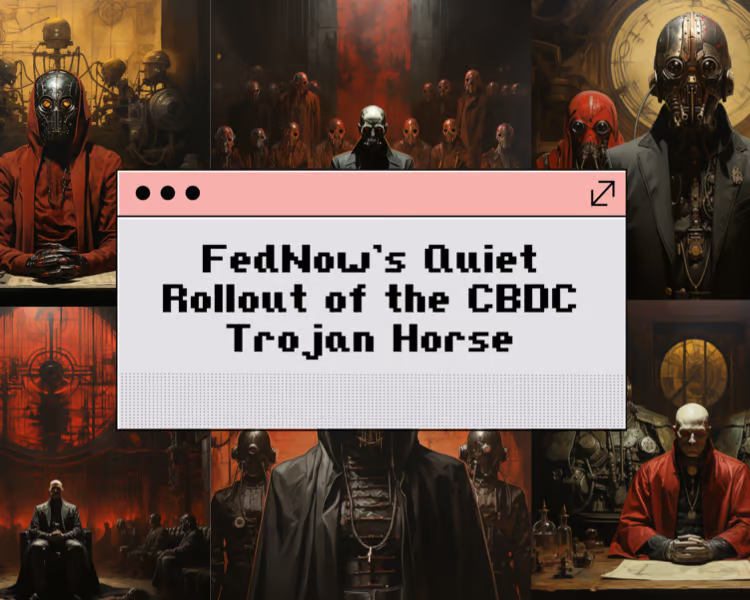If you’ve been following the financial world even tangentially, you might have heard whispers about CBDCs or something called FedNow.
Well, it’s time to turn those whispers into clear, loud conversations.
Why?
Because understanding FedNow isn’t just about knowing the next financial trend; it’s about understanding the balance between progress and personal privacy, between convenience and control.
What’s the Buzz About?
Last Thursday, on July 20th, 2023, FedNow was rolled out.

FedNow is a Trojan Horse for CBDCs
Think of it as a shiny, brand new system that speeds up payments like never before.
So far, 37 financial institutions and 17 top-notch payment service providers have given it the thumbs up and are on board to use this service.
And guess what?
It’s not just the Wall Street big boys like JPMorgan Chase, Wells Fargo, and BNY Mellon who are already diving in.
Smaller community banks and credit unions, those hometown financial heroes, are also joining the party.
The Federal Reserve has published a full list of participating banks here.
Why Should You Care?
Imagine this: You’re out on a weekend getaway.
After a long day, you decide to treat yourself to a lavish dinner.
You reach for your wallet, but—oops!—you left it at the hotel.
But with systems like FedNow, that’s no longer a problem. A few taps on your phone and voilà, payment made!
Sounds like a dream, right?
But here’s the other side of the coin.
Every tap, every transaction, is a digital footprint.

And these footprints paint a pretty detailed picture of who you are, what you like, where you go, and so much more.
And with centralized systems like FedNow, the control of that data might slip a little more towards big organizations and, possibly, governmental agencies.
It’s like leaving your diary open on a park bench.
Sure, most people might just walk by.
But what if someone decides to take a peek?
Background of FedNow
The origins of FedNow trace back to 2013.
In September of that year, the Federal Reserve unveiled a public consultation paper, a significant hint of the innovations to come in the financial world.
Behind the scenes, the influential Bill and Melinda Gates Foundation played a crucial role, propelling the inception and evolution of FedNow.
Fast forward a few years to July 2017, and the clarion call for change became louder.
A special Task Force Report emphasized the growing need for a new system capable of zipping payments around like quick text messages.
But 2019 was the game-changer.
That August, amidst a backdrop of tech and financial advancements, the Federal Reserve officially announced FedNow.
The timing was intriguing.
Almost simultaneously, the world was buzzing about Facebook’s ambitious digital currency project, ‘Libra’, and the World Economic Forum’s collaboration with the UN.
While these events might be mere coincidences, they certainly highlighted the shift in the financial landscape.
The Mechanics of FedNow
When diving into how FedNow operates, one can draw parallels to Central Bank digital currencies (CBDCs).
If you imagine CBDCs as the digital transformation of our usual paper money, then FedNow emerges as its more tech-savvy and centralized relative.
What sets it apart?
Its programmability. Picture a grand orchestral performance where every note from each instrument is under the maestro’s control.

Similarly, in the world of FedNow, a central authority can orchestrate every transaction.
However, the idea of FedNow as a cryptocurrency brings in another dimension.
Conceptualize it as a foundational element or a ‘layer-zero blockchain’ in the digital currency ecosystem.
At its core, FedNow offers fundamental services like routine transactions and report creations.
But its capabilities stretch beyond the basics.
It can tailor limits on how much one can transact, or even selectively blacklist certain accounts.
It’s akin to having a credit card that restricts you from buying specific items or exceeding set limits.
❝
Irrespective of one’s political leanings, the incident with the Canadian truckers—who found their bank accounts abruptly frozen amidst their protests—stands out as a stark reminder of unchecked authority.
Such events underscore the profound implications of endowing governments and banks with unchecked access and control over individual financial assets.
Addie LaMarr
An interesting twist in the FedNow narrative is its exclusivity.
It’s not as accessible as one might think.
Only those banks possessing what one could call a ‘Master Key’ or Master accounts have direct access to FedNow.
For others, the entry is more indirect, reminiscent of a private club’s exclusivity where only members have unrestricted access.
The Broader Context
Looking back to 2019, we see a seismic shift in the financial landscape.
That year bore witness to the rapid emergence of digital currency projects, with Facebook’s Libra being a prominent example.
Around the same time, the World Economic Forum teamed up with the United Nations, focusing on Sustainable Development Goals (SDGs).
What many might not realize is the deep-rooted association these goals shared with Central Bank Digital Currencies (CBDCs).

An intriguing plot twist was BlackRock’s forecast which, eerily enough, predicted the response of central banks and governments in the event of a pandemic.
As the waves of these developments ebbed and flowed, new debates arose.
One such debate centers around whether platforms like FedNow could stand toe-to-toe with popular cryptocurrencies.
An interesting detail to note is the ISO 20022 standard compatibility.
This is a universal banking standard and, intriguingly, shares a connection with Ripple’s XRP.
This brings to light speculation surrounding Ripple’s lawsuit by the SEC.
Ripple posed a potential threat to systems like FedNow as a competitor.
Privacy Concerns and Centralized Control
Now, let’s shift gears to something many of us hold dear: privacy.
Unlike our familiar banking systems that clock out after business hours, FedNow is slated to be a round-the-clock operation.
But, here’s a hiccup – a thorough scan of FedNow’s documentation reveals a deafening silence on user privacy.
Dive deeper, and it becomes evident that users might be trading off their transactional privacy in this new realm.
While FedNow claims to combat fraud, its measures might remind some of the “Patriot Act.”

On the surface, the Patriot Act seemed a benign effort to safeguard national interests, but many view it as a sweeping initiative to augment government control, monitoring its own citizens covertly.
Similarly, FedNow’s tools, like generating reports on “suspicious” transactions and account blacklisting, may seem like protective measures.
But these could very well be a Trojan horse, not genuinely about combating fraud but rather establishing a comprehensive system of control and oversight.
The balance between safety and freedom is delicate, and the question arises:
What freedoms are we willing to forego for the illusion of security?
The Road Ahead for FedNow
As FedNow makes its presence known in the financial landscape, its path forward remains somewhat enigmatic.
Rather than presenting a clear roadmap, the development approach is distinctly phased.
This means that, while we know certain features are in the pipeline, there’s a degree of mystery about when they’ll roll out or how they might evolve.
A crucial player in this development is the “FedNow Community,” a collective of bankers and politicians responsible for deciding which features make the cut.

Their decisions will be pivotal in shaping the platform’s future.
Speaking of the future, the FedNow fast payment system’s roadmap will have a transformational shift — the metamorphosis of the US dollar into a Central Bank Digital Currency (CBDC).
If this were to materialize, it would position the US in direct competition with other countries, like China, who are already making strides with their own CBDCs.
We all know how dystopian that one is, with its capability to subtract money from citizens accounts for breaking menial laws.
A particularly noteworthy aspect of FedNow is its programmability and emphasis on tokenization.
Programmability, in essence, will enable certain conditions to be attached to transactions.
It will allow those in power to manipulate the currency at will.
For instance, a payment could be automatically rejected if it doesn’t meet predefined criteria, adding a new layer of control.
The Bigger Picture
But what does all this mean for banks and the general public?
There are whispers that banks with Master accounts could soon find themselves obligated to adopt FedNow.
On the surface, this might appear to be a step forward. But dig deeper, and the implications become unsettling.
If true, it might lead to the vanishing of financial privacy as we know it, handing over an unprecedented level of control to the Federal Reserve.

As for the public, the allure of FedNow will likely be hard to resist.
The prospect of instant settlements and a slew of initial benefits will probably see many quickly embracing the system.
However, a word of caution is warranted.
As FedNow becomes more dominant, it also gains more power. And as history has shown, unchecked power in any domain often leads to its misuse.
The question, then, becomes one of trust and vigilance.
Will the public and institutions remain alert to ensure that the balance of power remains in check?
Only time will tell.
Cryptocurrencies: Your Shield Against an Orwellian Future
In an ever-evolving world of financial technology, there’s a clear divergence between paths that lead to a future of autonomy and those that drift towards an Orwellian society.
As the silhouette of the latter starts to come into sharper focus, each of us must grapple with a crucial question:
How do we navigate these tides and ensure our financial freedom?
FedNow, beneath its sheen of efficiency, may well be steering us into the clutches of overarching control.
As centralized systems like these cement their place, the tracks of every transaction, no matter how minute, could be laid bare for the world to see.
The convenience these systems promise comes at a high price — the forfeiture of our financial privacy.

But we aren’t powerless in the face of this looming reality.
There’s a way out, a path that offers both protection and sovereignty.
Cryptocurrencies emerge as the antidote to this encroaching dystopia.
Beyond just being a financial tool, they represent a vision of the world where our financial choices remain untainted by undue influences.
They promise a realm where transactions aren’t just swift but also shielded from the prying eyes of centralized behemoths.
The onus is on each of us to take the reins of our financial destiny.
To sidestep the shadows of CBDCs and government overreach, we must educate ourselves, explore the world of cryptocurrencies, and embrace their transformative potential.
In them, we find more than just digital coins; we discover a beacon of hope.
A future where our financial freedoms are intact is within reach.
It’s a future worth striving for, and with cryptocurrencies lighting the way, it’s a future that’s entirely attainable.
Stay Curious,
Addie LaMarr



